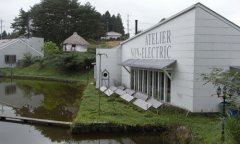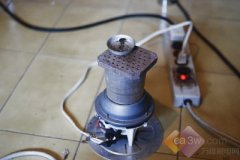Coffee roaster Museum introduces the basics of coffee
Since the mid-19th century, coffee-roasting technology has evolved from the simplest home stove with a pan to today's giant computer-controlled automated roasting equipment (which can roast nearly five tons of coffee beans per hour).

In 1877, German commercial roasters began to have patented design rights. It was a baking ball (Ball Roaster) designed by Emmerich, but the design was designed earlier by a 28-year-old engineer named Theodor von Gimborn.
This ball-type roaster is more stable than frying in a pan and can better control and retain the flavor characteristics of coffee beans. In 1868, a large equipment manufacturer in the Emmerich region merged with a German importer of raw beans to form a company specializing in coffee machinery called the Emmericher Maschinenfabrik & Eisengieserei, which is today's Probat.
The company was a quick success. Emmerich was the first company in the world to mass-produce a coffee roaster. In 1899, Emmerich produced the first patented gas fast roaster. Now in the 136th year of its establishment, the third and fourth generations of the von Gimborn family are still actively running the business.
Probat is located in an industrial zone on the outskirts of the Emmerich region, * near the Rhine, on the border between Germany and the Netherlands. A Coffee Technology Museum (Museum of Coffee Technology) has been set up on the flank of the company's main building to showcase generations of baking appliances made by the company and other countries, some of which are money-making equipment used by world-renowned leading stores for decades.
In 1978, the museum was established. The birth of this museum was indirectly influenced by the second World War. In 1944, the town of Emmerich was bombed by allies, causing damage to about 98 per cent of the town's building facilities, including the Probat factory, which was then in the center of the town.
After the war, when the company began to resume production in 1946, it faced difficulties everywhere. the original blueprints and factory equipment were all destroyed, and the main office and internal materials were all lost. the only way to bring the company back to life is to find customers who have bought machines and equipment from them in the past and redraw the engineering drawings of the machines.
If there is any opportunity to buy previously sold machines, Probat will also buy them back, rebuild them, or spare more existing machine models and store them in the warehouse for future use. After a while, because the machines piled in the warehouse were stained with dust, the company came up with the idea of setting up a coffee technology museum. Finally, in 1977, when the construction of the new office park in Probat was completed, the museum was located in its current location. Since then, the museum's collection has been growing, acquiring a variety of roasters whenever the opportunity arises, so that the museum has been expanded several times over the years.
The idea for the museum was put forward by Carl Hans von Gimbron, the third member of the family, who is now 80 years old and still serves as chairman of Probat Holding.
Today, the museum covers an area of 600 square meters and has a collection of more than 1000 pieces. In the museum, you can clearly see everything from the ball-type bean dryer to the patented Emmerich gas fast bean dryer in 1884 to the latest bean baking technology in the 20th century; in addition, there are about 50 commercial and industrial bean grinders, large and small.
In addition to industrial-grade machines, when a full range of store roasters and sample roasters were developed by ──, Probat was proud to mark the milestone of the company's 100th bean roaster (1931), and a display of battery-driven sample roasters made at the beginning of the 20th century can be seen in the corner of the museum.
Another very in-depth collection theme is more than 600 household coffee grinders. Many home bean grinders have a decorative function, so that the kitchen at home will have a Lounge or restaurant atmosphere, rather than just look like an ordinary kitchen.
The oldest commercial roaster in the collection is a ball roaster produced in 1870, which pours 5 kilograms of raw coffee beans into a spherical roaster and closes the mouth of the beans at a time. Then an operator turns the timing knob (it doesn't matter for adults or children) for 40 minutes. The fuel used at that time is coal or coke, and samples can be taken during the baking process, when the desired color is reached. Open the baking ball, pour the roasted coffee beans into a cooling sieve, and rake repeatedly so that the coffee beans can cool quickly. The pace of the whole process was slow, but in the 19th century, coffee drinkers were much lower than they are today and were considered a luxury consumer product.
The collection also includes an industrial bean baking equipment and a SB drum dryer equipped with two bean grinders, driven by a drive motor and fueled by coke, which has been used by a company from 1900 to 1981. Is this probably the longest-lived bean dryer in the world? the Probat Museum was acquired as part of its collection because its original owner decided to let it retire.
At the entrance to the museum, there is a kitchen modeled from the early 19th century, where a housewife uses a hand-held family-style drum bean dryer with a fire burning below, while her husband plays with a bean grinder. There are many simple bean baking rollers and pans (with stirring rods) used on home stoves in the 18th and 19th centuries, and home baking is very popular all over Europe until the early 20th century.
The purpose of the museum is not simply to introduce coffee roasters made by Probat itself, it also covers all kinds of bean roasters made by competitors, showing the history of coffee technology. Some of the competitors in the past are still on the market, but others are now subsidiaries of Probat. There are many roasters in the collection from Jabez Burns, America's largest manufacturer, which grew during the Civil War because coffee became a necessity in the military. The oldest model produced by Burns is Burns No. 1, which uses coke as the source of fire and can bake two bags at a time (one bag is about 60 kilograms).
On the turf outside the museum are also displayed two bags of coke-burning drum roasters produced in the 1930s, with a built-in cooling system, and another one-bag baking ball roaster made in the 1900s. The exterior of the office building is also decorated and decorated with parts of the roaster.
Important Notice :
前街咖啡 FrontStreet Coffee has moved to new addredd:
FrontStreet Coffee Address: 315,Donghua East Road,GuangZhou
Tel:020 38364473
- Prev

Non-electric coffee bean roaster made by Japanese engineers
Yasuyuki Fujimura is a non-electric studio built in Natsucho, Japan. In 1953, the world's first washing machine was introduced in Japan; in the same year, the national color TV standard was set. Since then, household appliances began to enter thousands of households, so 1953 is also known as the first year of electrification. The beginning of the electrification era marks the peak of human demand for energy. Nowadays, human beings have become dependent on electric energy.
- Next

Super strong! Look at the coffee roaster modified by the popcorn machine.
Coffee is becoming more and more popular among ordinary people. It can not only be used as a drink, but also can effectively play a refreshing role and ensure work efficiency. But it is not so easy to get an authentic cup of coffee. First of all, the roasting of coffee beans is a problem. A netizen transformed the old popcorn machine at home into a coffee bean dryer, and then used the coffee machine to extract coffee.
Related
- Beginners will see the "Coffee pull flower" guide!
- What is the difference between ice blog purified milk and ordinary milk coffee?
- Why is the Philippines the largest producer of crops in Liberia?
- For coffee extraction, should the fine powder be retained?
- How does extracted espresso fill pressed powder? How much strength does it take to press the powder?
- How to make jasmine cold extract coffee? Is the jasmine + latte good?
- Will this little toy really make the coffee taste better? How does Lily Drip affect coffee extraction?
- Will the action of slapping the filter cup also affect coffee extraction?
- What's the difference between powder-to-water ratio and powder-to-liquid ratio?
- What is the Ethiopian local species? What does it have to do with Heirloom native species?

